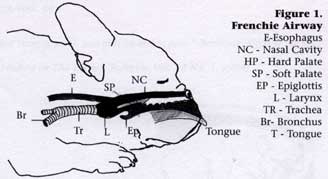|
French
Bulldog
First
partHow many times have you heard of a French Bulldog who died young, suddenly,
and without warning, with the death generally attributed to “a heart attack”?
Such deaths, most often occurring when the dog is excited, being exercised,
or hot, are all the more devastating because of their unexpectedness. True,
the heart unquestionably stops beating, but could this be the result of
death from another cause? A condition that may explain such deaths is an
acute airway collapse, resulting from long-standing airway obstruction
by the too-common French bulldog problems of stenotic nares, elongated
soft palate, and crowded nasal passages and pharynx.
Like
humans, dogs “pull” air into their lungs by a process called “negative
pressure breathing”. Instead of pumping air into the airway under positive
pressure (which is what frogs do, by moving the floor of the mouth up and
down and to “push” air down the airway), dogs (and we) expand the chest
cavity by moving the ribs outward and the diaphragm downward. Since the
chest cavity is a closed space, this expansion produces a partial vacuum,
or space within which the air pressure is lower than that outside the body
(“negative pressure”). Nature, which abhors even a partial vacuum, remedies
this by allowing outside air to rush in through the nares, nasal cavities,
pharynx, larynx and trachea, and finally via the bronchi and bronchioles
into the air sacs of the lungs. This inflates the lungs, and the pressure
in the chest cavity becomes equal to that of the outside air.
Figure
1 shows the different parts of the Frenchie airway. Consider first the
nares. In some dogs, the nasal openings are big enough that air moves freely
in and out. In others, they are stenotic (constricted or narrowed). Try
forcibly inhaling air while being aware what your own nose is doing; notice
how the sides of the nose cave in somewhat, as the forced inspiration pulls
them inward? Now, try inhaling while pinching your nostrils shut; feel
the “sucking inward” in your nasal cavities and throat? In a FRenchie with
a small nasal opening, the sides of the nose act like flap-like valves
that even a slight respiratory effort pulls tightly shut. You can see and
hear the difference in breathing between a dog with open nares and one
with stenotic ones. The harder the dog tries to breathe, the more tightly
the nares clamp shut, and the more the walls of the airway are pulled inward.
Moving
down the airway, we next come to that bugaboo of flat-faced breeds, the
soft palate, which separates the back end of the nasal cavity from the
mouth cavity. Although some brachycephalic dogs have a soft palate that
is short and in proportion to the abbreviated bony skull, many of them
have an overly long soft palate that hangs far down into the pharynx (throat).
This excessively large palate not only interferes with airflow from nasal
chambers to throat, it can actually be drawn into the opening of the larynx.
This may cause so much turbulence of airflow that the tissues of the palate
become inflamed, thickened, and even more obstructive. One warning sign
of an elongated soft palate is frequent gagging and frequent regurgitation
of frothy saliva, usually not accompanied by vomiting of food. The elongated
palate seems to act like an eggbeater, so that when the dog salivates,
the palate whips the saliva into a froth, the dog gags, and up it comes
— usually on the carpet (which is why some of us now have all wood floors
with nary a carpet to be found anywhere in the house).
From
the nasal cavities, inhaled air moves through the pharynx and next down
into the larynx (voicebox). Actually just the expanded and elaborated upper
end of the trachea (windpipe), the box-like larynx consists of some cartilages
apart or together so as to open or shut the glottis, the opening between
the vocal cords that are attached to these cartilages. The epiglottis (‘epi’
meaning over), is a flap at the top of the larynx that folds down and covers
the glottis during swallowing, so that the food doesn’t enter the airway
by mistake. People who try to talk and eat at the same time, often confuse
the epiglottis, resulting in food’s getting into the glottis and plugging
up the airway; this is the so called ‘cafe coronary’ for which the Heimlich
Maneuver is done.
When
stenotic nares, elongated soft palate, or both cause chronic airway obstruction,
the increased effort to pull air into the compromised airway exerts an
ongoing stress on the walls of the larynx, in effect sucking them inward.
First,
it pulls inward on the laryngeal ventricles (laryngeal saccules); these
little out pocketing of the thin membrane lining the larynx are located
just above the vocal cords. Chronic airway obstruction everts these little
membrane sacs, so instead of sticking outward, they are pulled inward and
into the glottis, further clogging the already bad airway. Everted saccules
not only result from chronic airway obstruction, but also aggravate the
problem.
Any or all of the above may persist for some time, without the owner’s being aware that the airway’s condition is becoming progressively worse due to the vicious cycle of airway obstruction > airway changes > worse airway obstruction. Then, unexpectedly, the dog may have a respiratory infection that causes some swelling, or gets excited, hot or exercised once too often. And suddenly the partially collapsed larynx or trachea may totally collapse, or the everted saccules or soft palate may plug the glottis. The end result: asphyxiation, which unless the owner was aware of the problem, may be seen as “sudden death due to heart failure”. So
what is to be done?
* Are
the nares obviously stenotic? Can you see and hear them interfering with
each intake of breath?
If
you answer ”yes” to any or all of these, your Frenchie may need further
evaluation and, if indicated, surgery. A warning, though: some of the procedures
used in treating this syndrome are not simple! If you have a vet with large
Bulldog practice, she or he may have considerable experience with the brachycephalic
syndrome, and may be perfectly competent to evaluate and treat your pet.
If not, consider asking for referral either to a Vet School hospital, where
there state-of-the art intensive facilities and specialists in surgery,
anesthesia, and posoperative care.
If it appears likely that there are serious airway problems, the vet must anesthetize the dog to evaluate it properly. The exam may be done under light anesthesia, but if the exam shows that surgery is needed, then the anesthesia can be deepened and the procedure done at the same time under the same anesthesia. Anesthesia carries risk for Frenchies in any event, and even more so when there is an airway problem; therefore it should be done as seldom as possible.
If
the dog has stenotic nares, elongated soft palate, and everted laryngeal
saccules, all should be corrected at the same surgery. Bear in mind that
the procedure on the nose will alter the appearance somewhat, this may
cause a dilemma if you are showing the dog. However, if the nares are responsible
for a significant proportion of the obstruction, then shortening the palate
and removing the saccules may not solve the problem, since the airway is
only as good as its opening to the outside. If you are not showing the
dog, then the minor change in the nose is a small price to pay for a healthier
Frenchie.
In
shortening the palate (a procedure called staphylectomy) the vet must take
special precautions to maintain an open airway during and after surgery.
First, of course, the dog should have an endiotracheal tube inserted that
is small enough to leave the surgeaon anough room to work in the pharynx
and larynx, but large enough to provide adequate air flow. Any manipulation
of the larynx can very easily cause rapid swelling that is severe enough
to close the airway. Therefore, a potent short-acting anti-inflammatory
drug should be given at the start of the procedure to minimize swelling
during surgery.
Removal of everted saccules (laryngeal sacculectomy) is a brief procedure, usually done at the same time as the nares and/or palate are treated, and it involves snipping the saccules out with scissors, or snaring them with a wire loop. It does not usually cause much bleeding, and it is much simpler than the palate shortening procedure. If the nares and soft palate are treated early enough, the saccules may not yet have become everted, and correction of the other problems should prevent this happening. If stenotic nares and/or elongated soft palate have lead to partial collapse of the larynx, then correction of the palate, nares and saccules may prevent further laryngeal or tracheal collapse, and although some surgical procedures may help with certain cases, these are very complex, not always successful, and usually done only as a last resort. Some vets recommend a tracheostomy (permanent opening through the neck into the trachea) as the preferred treatment for accute laryngeal collapse. We will assume that Frenchie owners, once alerted to the problem, will have the nares and/or palate problems corrected before the collapse occurs. A further suggestion: don’t use any type of collar on a dog with any degree of airway impairment, to avoid putting any additional stress on the trachea. Even the most ox-like Frenchie neck may conceal a fragile airway, so a well-fitted harness is much better for the dog. And at least one Frenchie (who shall be nameless) has shown that a harness may even be used for obedience-training. What
about the significance of the brachycephalic syndrome for the Breed?
If
breeders would begin accumulating data about palate elongation in their
lines, then when the GDCIS database is available, we can help determine
whether this soft palate problem can be solved by selective breeding.
A French Bulldog’s quality of life requires good breathing. If we all try to insure that each pup can lead an active life, and that airway problems in the breed as a whole become the exception instead of the norm, then we will all breathe easier... Frenchies and their owners alike. hen
check the mouth for the foreign body and repeat the procedure, if necessary.
Please note: this is only to be used for a complete airway blockage by
a foreign object, at which time the heart will still be beating.
From
“Healthy Frenchies: an Owner´s Manual”. Published by ArDesign. USA.1998
|
 The
Brachycephalic Syndrome
The
Brachycephalic Syndrome



